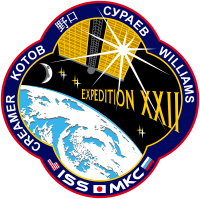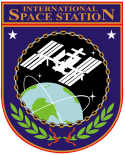Ekspedycja 22
| ||
 | ||
| Dane misji | ||
| Oznaczenie kodowe | Ekspedycja 22 | |
| Pojazd | ||
| Pojazd dowożący | Sojuz TMA-16, Sojuz TMA-17 | |
| Pojazd powrotny | Sojuz TMA-16, Sojuz TMA-17 | |
| Załoga | ||
 | ||
| Załoga | 5 | |
| Start | ||
| Miejsce startu | Bajkonur | |
| Początek misji | 20 grudnia 2009, 21:52 UTC (Sojuz TMA-17) | |
| Wyjście w przestrzeń kosmiczną | 1.EVA – 5 h 44 min | |
| Misja ISS | ||
| Lądowanie | ||
| Miejsce lądowania | Kazachstan | |
| Lądowanie | 18 marca 2010, 11:24 UTC (Sojuz TMA-16) | |
| Międzynarodowa Stacja Kosmiczna | ||
Ekspedycja 22 – dwudziesta druga ekspedycja na Międzynarodową Stację Kosmiczną, która trwała od 30 listopada 2009 r. (odcumowanie Sojuza TMA-15) do marca 2010 r. Załoga stacji była niepełna (pełny skład wynosi sześć osób) ze względu na miejsce zajęte w Sojuzie TMA-16 przez turystę kosmicznego Guya Laliberté z Kanady.
Załoga
Załoga stacji składała się początkowo z dwóch, a później z pięciu członków. Jeffrey Williams i Maksim Surajew przeszli z Ekspedycji 21, pozostałych trzech astronautów przyleciało na stację 22 grudnia 2009 na pokładzie Sojuza TMA-17.
- Jeffrey Williams (3) Dowódca – NASA
- Maksim Surajew (1) Inżynier pokładowy 1 – Roskosmos
- Oleg Kotow (2) Inżynier pokładowy 2 – Roskosmos
- Timothy Creamer (1) Inżynier pokładowy 3 – NASA
- Sōichi Noguchi (2) Inżynier pokładowy 4 – JAXA
Liczba w nawiasie oznacza liczbę lotów odbytych przez każdego z astronautów, łącznie z Ekspedycją 22.
Zobacz też
Bibliografia
- Ekspedycja 22 na stronie NASA (ang.)
- ISS: Expedition 22 (ang.). Space Facts, 2014-07-05. [dostęp 2014-07-13].
Media użyte na tej stronie
Expedition 22 crew members. From the left (front row) are NASA astronaut Jeffrey Williams, commander; and Russian cosmonaut Oleg Kotov, flight engineer. From the left (back row) are NASA astronaut T.J. Creamer, Russian cosmonaut Maxim Suraev and Japan Aerospace Exploration Agency (JAXA) astronaut Soichi Noguchi, all flight engineers.
The 22nd Expedition to the International Space Station is dedicated to the final stages of assembly and the transition to full utilization as an orbiting laboratory. The sun, providing power and life support to the space station, shines through one of the solar arrays as the ISS orbits above Earth. The oceans and atmosphere, providing life support to Earth, are shown in all their beauty. The moon hovers in the distance as the goal of the next era of exploration. The six stars illustrate the increased capability of the crew complement. In the border are the national flags of the crew members as well as their surnames in their native languages. Expedition XXII continues the effort to acquire the knowledge necessary to extend the reach of exploration from Earth, to the moon and beyond.



